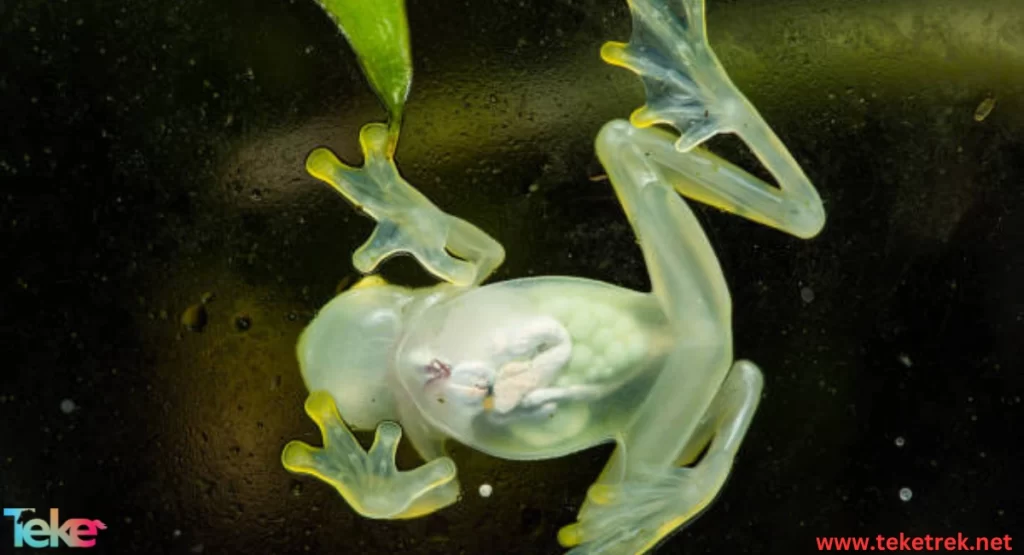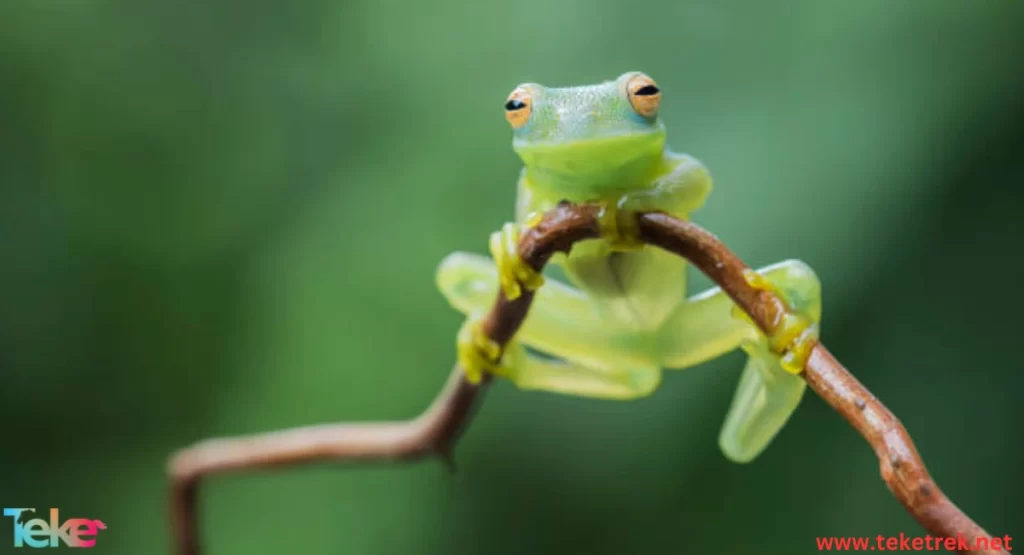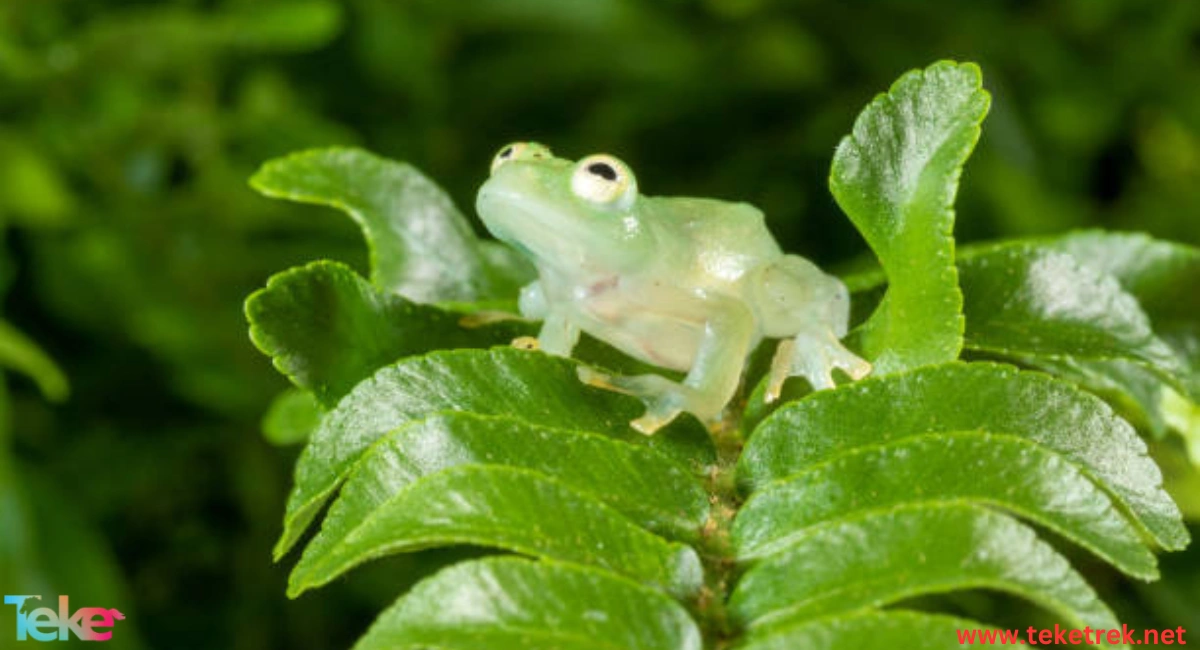The glass frog belongs to the frog family, which belongs to the amphibian family, and its scientific name is Centrolenidae.
Let’s learn more about it from teketrek.
The Glass frog fun facts: What is special about the glass frog?
Glass frogs are known as a group of small tree frogs that are found in tropical regions around the world.
They live in lowland forests and extend to mid-mountain forests.
These frogs are named because many of them have transparent bellies and chests.
Until their internal organs are exposed to the observer through their transparent skin.
Glass frogs have the ability to climb significantly, which makes them prefer living on tall trees in vast forests.
Glass frogs are considered arboreal creatures, meaning they live on trees and spend most of their time close to water.
One of the main features of glass frogs is that they are nocturnal animals, feeding at night and hunting prey.
At night, they hide without moving and live-in small groups called “army.”
Glass frogs are adept at hiding and camouflaging.
Some of them have transparent undersides which help them in this.

The glass frog specification
The color: Glass frogs are characterized by their transparent bellies and chests. However, not all glass frogs have transparent undersides. Most glass frogs appear in a bright light green color when observed. Their colors usually range from fluorescent green to natural green, with random spots distributed on their bodies. The color of these spots’ ranges between white and yellow.
The glass frog size: Glass frogs are relatively small in size.
The length: adults ranging in length from about 20 to 30 mm.
The weight: As for their weight, it ranges from about 5 to 14 grams.
The Eyes: Glass frogs have bulging eyes that are directed forward. Their color in many frogs is also blue, gold, or gray. They have excellent vision, which helps them catch insects for food.
What does the glass frog eat
Glass frogs are known as carnivorous animals.
They feed on various small insects, including spiders, ants, cockroaches, mites, as well as flies and small insects crawling along tree branches. Sometimes they also eat small frogs.
As for the hunting style of glass frogs, it involves remaining still and waiting for their prey.
They allow their prey to crawl into their range before extending their tongue towards them to consume them.
Glass frogs live for 10 to 14 years if they avoid being eaten by predators. They can also adapt if any climatic changes require it.
Glass frog habitat: where glass frogs are found?
Glass frogs live in lowland tropical forests, and mid-mountain forests in Mexico, Central America, and South America.
They live in forested areas near water bodies in the mountains, which they need for breeding.
Glass frogs have been found in the Andes Mountains in Venezuela, Tobago Island, Bolivia.
Some species also live near the Amazon and Orinoco rivers, the Guiana Highlands region, southeastern Brazil, and the northern part of Argentina.
During the dry season from late November to April, glass frogs live in trees.
Reproduction stages of glass frogs
The mating season for glass frogs begins during the rainy season.
As soon as the forests become moist, the glass frog descends from the trees.
The male emits a high whistle to call females, who are attracted to him when they are in their ovulation period.
The female lays eggs all at once, and the male fertilizes them.
She may lay up to 30 eggs all at once.
They are covered with a clear substance like liquid glue to secure them safely on a leaf.
After laying the eggs, the female returns to the trees, leaving the male to incubate and care for the eggs.
The incubation period can last for about two weeks.
Once the male guards a group of eggs, he whistles again to call another female to lay more eggs.
The male may guard as many egg clusters as can fit on a large leaf.
After the eggs hatch, the leaf falls into the water, and the tadpoles live at the bottom of the pond for up to ten months until they grow into adult frogs.
The adult frog remains alive until reaching maturity. It then climbs back from the water to the trees to join the rest of the glass frog family waiting for it.
Predators of glass frogs
Tree-climbing snakes are among the animals that prey on glass frogs, along with some birds.
During the mating season when glass frogs come down from trees, they are preyed upon by various small lizards and mammals.
As for the eggs, they are considered a light and delicious food source for wasps.
The Narrow-barred Spanish: Discovering the Unique Beauty of This Endangered Species
Threats to glass frogs
Continuous encroachment by humans through deforestation is one of the main threats facing this species of frogs.
Many poachers also try to catch them for sale as part of the rare animal trade.

FAQs of glass frogs
How rare are glass frogs?
Glass frogs are considered very rare and are classified as Endangered by the International Union for Conservation of Nature (IUCN). Their name comes from the yellow, eye-like dots on their bodies. They inhabit areas near streams and well-preserved forests where they reproduce.
- Are glass frogs extinct?
More than half of glass frog species are now threatened with extinction, with 71 percent of the evaluated species showing a decline in the wild.
- Does the glass frog have teeth?
Glass frogs lack teeth and have a short tongue. They are insectivores, feeding on insects such as ants, small spiders, crickets, and flies.
- Do glass frogs sleep?
When glass frogs sleep during the day, up to 90 percent of their red blood cells can cease circulating throughout their bodies.
- How do glass frogs hunt?
Glass frogs hunt at night, using their large forward-facing eyes to detect prey. They search for insects, spiders, and other small creatures while hopping among tree branches.
- Are glass frogs poisonous
No, it is not toxic.
- Why is the glass frog so hard to see?
Because it spends its life on trees and gets lost among the leaves.
- How long does the glass frog live?
Glass frogs live for 10 to 14 years if they avoid being eaten by predators.
In conclusion, glass frogs is important to emphasize the importance of securing sufficient protection for this species of frogs through efforts by the International Union for Conservation of Nature and by countries where glass frogs live.
References





